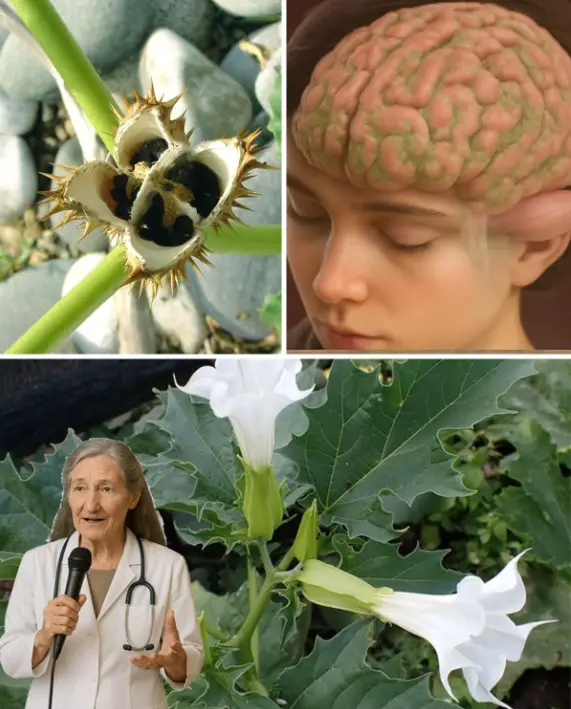Have you ever admired a stunning, trumpet-shaped flower blooming in your yard or a neighbor’s garden—unaware it could be dangerously toxic? Datura, also known as devil’s trumpet or jimsonweed, is a captivating yet hazardous plant that grows wild across the U.S. and is sometimes cultivated for its ornamental value.
Despite its dramatic blooms and sweet fragrance, every part of this plant is packed with powerful toxins. Understanding how to identify and manage Datura could prevent serious health risks for you, your children, and your pets.
What Is Datura?
Datura is a genus in the nightshade family (Solanaceae), native to Central America but now found throughout the U.S. It thrives in disturbed soils—roadsides, fields, and even backyards.
Also known as:
- Devil’s trumpet
- Jimsonweed
- Thornapple
According to WebMD, all parts of Datura contain tropane alkaloids—notably atropine, scopolamine, and hyoscyamine—which can severely disrupt the nervous system. These compounds are toxic to humans and animals, even in small amounts.
Why Datura Is Dangerous
The plant’s alkaloids affect both the central and peripheral nervous systems. A 2017 study in Clinical Toxicology confirms that ingesting even small quantities—especially seeds or flowers—can lead to anticholinergic syndrome, with symptoms ranging from distressing to life-threatening.
Common Symptoms of Datura Poisoning:
- Hallucinations and delirium: Often intense and frightening; effects can last 24–48 hours or more
- Dilated pupils and blurred vision
- Dry mouth and extreme thirst
- Rapid heartbeat and elevated blood pressure
- Seizures, respiratory failure, or coma in severe cases (BMC Public Health, 2022)
Toxicity varies wildly depending on the plant part, growing season, and even the individual plant—making accidental ingestion especially risky.
How to Identify Datura in Your Yard
Per Wisconsin Horticulture, these key features can help you spot Datura:
| Feature | Description |
|---|---|
| Flowers | Large, trumpet-shaped, white to purple, 2–4 inches long; bloom at night with a strong sweet scent |
| Seed Pods | Round, spiky “thornapples” that split open when mature |
| Leaves | Broad, lobed, slightly fuzzy, gray-green in color |
| Height | 1–4 feet tall, with a bushy, sprawling growth habit |
| Scent | Sweet floral scent at night; leaves emit an unpleasant odor when crushed |
If you suspect you have Datura on your property, do not touch it with bare hands, and be cautious with children and pets nearby.
How to Stay Safe Around Datura
To protect your household from accidental exposure:
- Never consume any part of the plant, including seeds, flowers, or leaves
- Wear gloves and long sleeves when handling or removing the plant
- Keep pets and children away from Datura plants
- Dig up the plant completely (including roots), and dispose in a sealed bag—never burn it, as inhaling the smoke is harmful
- Wash your hands and clothes thoroughly after any contact
If someone ingests or is exposed to Datura, call Poison Control immediately (1-800-222-1222) or seek emergency care. Symptoms typically appear within 30–60 minutes.
Datura in Tradition and Misuse
Historically, Datura has been used in traditional medicine, especially in Ayurveda, where Datura metel was cautiously used for conditions like asthma and pain (Phytochemistry, 2021). However, due to its toxicity, it’s banned or restricted in many regions.
Misuse Warning:
Some individuals, especially teens, experiment with Datura for its hallucinogenic effects—a dangerous trend. A 2024 case in the International Journal of Emergency Medicine described a toddler’s accidental poisoning, underscoring the urgent need for community awareness.
What to Do If You Encounter Datura
If you discover Datura growing nearby:
✔️ Safe Options:
- Leave it alone if it’s in a wild, low-traffic area (it supports pollinators like moths)
- Remove it safely if it’s near homes, schools, or parks
- Educate others—especially children, teens, and neighbors
- Consult a local extension office for help with safe removal
- Replace with non-toxic plants like lavender, echinacea (coneflower), or bee balm
Why Awareness Matters
Datura’s breathtaking flowers may suggest beauty—but they hide serious danger. Whether growing wild or intentionally planted, Datura should be handled with caution. Understanding its risks, identifying it correctly, and spreading awareness can help protect your family, pets, and neighbors.
Have you seen Datura in your neighborhood? Share your experience or gardening tips in the comments to help others stay safe.
Disclaimer
This article is for informational purposes only and does not substitute medical advice. Always consult a healthcare professional or poison control center if exposure or poisoning is suspected.
